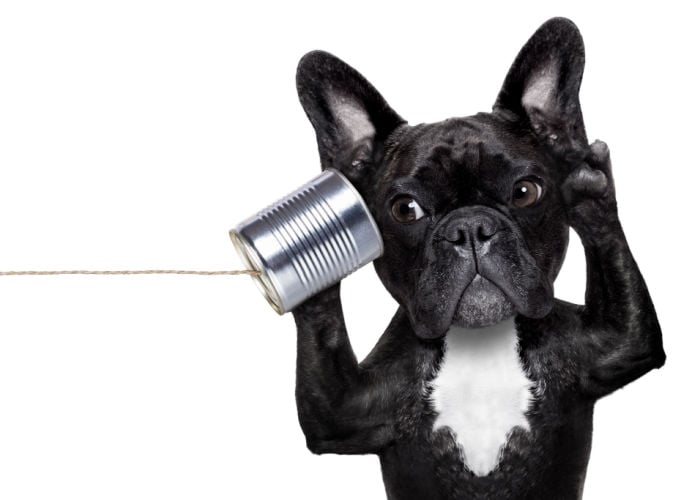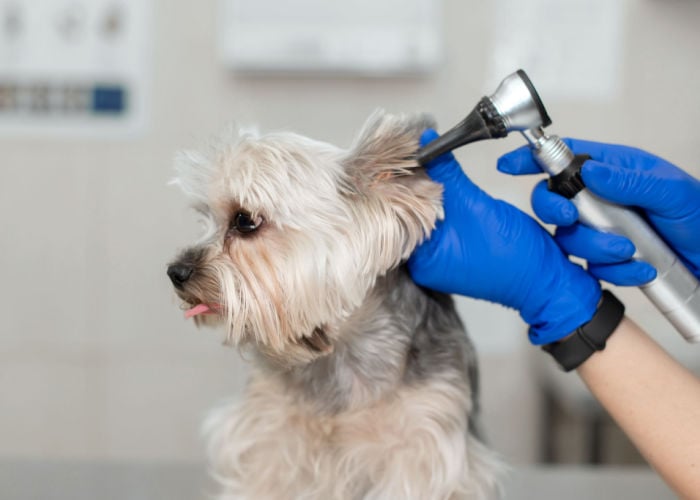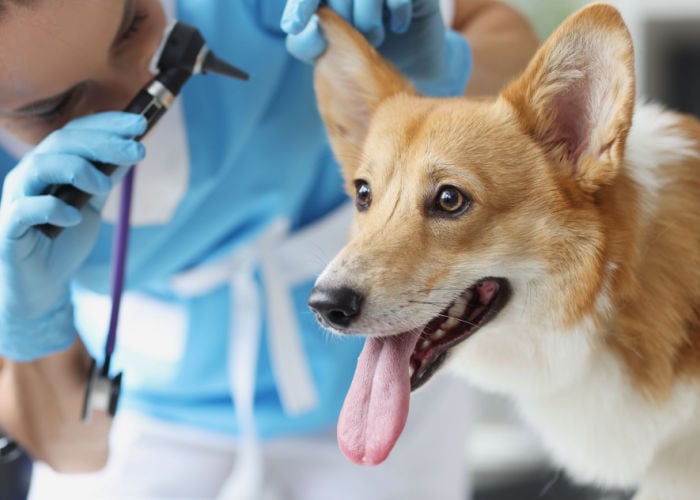Table of Contents
Have you heard about deaf dog myths? Rumors that deaf dogs aren’t able to do this or that like a normal dog?
Being unable to hear is a challenge, another challenge is the stereotypes and myths that come with it!
Sadly, there are stereotypes or famous myths regarding deaf dogs that aren't the best for their image.
Of course, things are a bit different when it comes to deaf dogs. For instance, a deaf dog's training will be different.
However, the list below is a few that are commonly mistaken by a lot of dog owners.
If you're on the fence about adopting a deaf dog because of a few characteristics you've heard about them, maybe we can debunk them.
But before that, let's shortly discuss the cause and symptoms of deafness in dogs.

Deafness in Dogs
Deafness in dogs may be a result of different situations.
Some dogs are congenitally deaf or deaf from birth. Other dogs become deaf after an accident or physical trauma because they have ruptured parts of the ear.
While some are due to diseases like Otitis Externa or an undue amount of wax build-up, there are other causes of deafness as well such as loss of myelin, loud noises, and more.
Some symptoms in deaf dogs are:
- Fewer Ear Movements
- Irresponsive to Vocal Cues
- Visible confusion when Commanding through Vocal or Other Sound Cues
- Unusually loud barks
These symptoms are one of the prominent signs that the dog is either having a difficult time hearing or is not able to hear at all.
Diagnosing deafness will include consultation, physical evaluation, observation, and sometimes some tests may be done as well.
It’s important to determine if a dog is deaf or not so owners can cater to the dog’s condition.
Treatment for deafness may revolve around their certain condition and cause.
Some deafness conditions have no known cure such as congenital ones. Some may require medications and surgery as well.
Before indulging in these speculated myths, owners may research, or even better, ask their veterinarian or professionals about the said myth.
We’re here to discuss some myths about deaf dogs and clarify them as well.
Here are the following myths that owners should be cautious of them!

Deaf Dog Myths: Dispelling Common Misconceptions
Deaf Dogs Have a Low Quality of Life
Sadly, some dogs are up for euthanization due to congenital or accidental deafness.
Some people deem that these dogs are no longer of help and no longer capable. Not knowing the sight of hearing can be a small part of the difference.
Deaf dogs are still capable of doing as much as non-deaf dogs.
They can interact, help around, train, play, exercise, venture and so much more. The only difference is there’s nothing they can hear!
It only reflects how their owners or families, and even the people around them treat them even when they have a hearing disability.
If the dog is excluded due to its ability, it may feel lonely. But if they can join activities and just be a bit more considerate of them, there won’t be any problem!
All Deaf Dogs are White
Not all deaf dogs are white. Some congenital deafness is found to be associated with coat colors.
Dogs that carry the piebald gene, which functions to distribute white pigmentation, are often found to be more prone to deafness.
If owners suspect their dog is deaf, owners should have their dogs checked and tested by their veterinarian.
There, they will be able to figure out if it’s bilateral or not and the grade of deafness with their dog.
Owners Can’t Communicate Well with Deaf Dogs
Owners may communicate with their deaf dogs just the same.
Although the sounds aren’t recognizable, they will rely on visual cues such as hand gestures, facial expressions, or other visual items needed by the owner to communicate with their dog.
Owners may even use hand signals like waving to approach their dog if they’re facing each other
Some messages may need repetitive exposure for the dog to understand a certain message or command.
In no time, they’ll be able to register the information and recognize it the next time around. It’s just the same with normal dogs.
Deaf Dogs are Difficult to Train
There is a huge misconception regarding training deaf dogs.
People think dogs are more accustomed to being trained and learning through recognizing sound alone. But animals are also visual communicators.
Training dogs includes variables such as commands, treats, sounds, and visual signs.
The only difference with deaf dogs is deducting the sound cues. Dogs are resourceful to adapt to what senses they have.
Since they lack the sense of hearing, they’ll be more invested in learning through sight. They’ll be able to learn the same with non-deaf dogs.
You may need a little bit of patience, especially with the young ones, but they’ll learn in no time as well.
Deaf Dogs are More Aggressive
Naturally, dogs' and humans’ reaction to being startled is being defensive or protecting one’s self. This goes for deaf dogs as well.
Since their sense of hearing is disrupted, they really on their other senses more.
When they encounter a situation where they are suddenly approached, they may flinch or attempt to bite since they would feel unsafe or in danger.
That’s why it’s important to know how to approach a deaf dog.
It’s not that they’re aggressive alone but they may become overprotective of themselves.
It’s our responsibility as owners to make them feel safe and approach them more comfortably and safely for both the dog and the owner.
Over time, if the dog feels safe, comfortable, and reassured, it will be less overprotective of itself and rather react accordingly.
Deaf Dogs are Prone to Accidents
This myth is often associated with the Always-On-Leash myth for deaf dogs as well.
Since these dogs have little to no hearing ability, people assume that they are prone to accidents.
This myth also assumes that some owners are being too careless with handling their dogs, especially with dogs with disabilities.
Deaf dogs may wander places but would be too cautious of their surroundings, especially when they’re unaccompanied and in an unfamiliar place as well.
Deaf dogs would stay close in proximity to their owners.

Frequently Asked Questions About Deaf Dog Myths
Do deaf dogs not bark?
Deaf dogs bark as well. When they’re trying to get attention or affirmation from the one they’re communicating with, they may respond with a bark.
Fascinatingly, deaf dogs’ bark is louder than normal dogs, since they aren’t aware yet if they are being noticed.
But over time, some deaf dogs tone down to their normal vocalization.
How do I wake up my deaf dog?
Owners may slightly tap or stomp the surface their dog is asleep in to notify their presence.
Since deaf dogs are more sensitive to vibration than sound, they’ll be able to recognize the signal that their attention is being pursued.
Some owners slightly blow on their dogs for them to sense a slight force on their surface.
Directly tapping a deaf dog may startle them and may respond accordingly, especially when done suddenly or by a stranger.
Are deaf dogs and children not compatible?
There is a lot to consider when adopting a deaf dog when the home has children residing in it.
Owners should consider, size, temperament, history, trainability, and level of activity.

Deaf Dog Myths: Summary
Above, we've discussed deaf dog myths. What are deaf dog myths you asked?
Well, these are common misconceptions about deaf dogs.
And these myths can be a hindrance for future pet owners that wants to adopt a deaf dog.
Although all dogs may be trained, some breeds are difficult to train regardless if they’re deaf or not.
If owners have narrowed down, they should first educate the child on how to approach a deaf dog as well as the do’s and don’ts.
If you're planning to adopt a deaf dog, keep in mind that deaf dog training is different.
But this can be a bond between you two. It'll be a great learning experience for them and you.
This goes the same for the dog's basic training. Early exposure and socialization are a must for them to understand how to interact with others.
Since these are all myths, owners should do research before having a prejudice against these deaf dogs.
Sadly, deaf dogs suffer heavily from these myths. They are euthanized or left last in shelters, even discarded easily.
With research and inquiring with veterinarians, we can provide and have a great quality of life with deaf dogs just fine.













